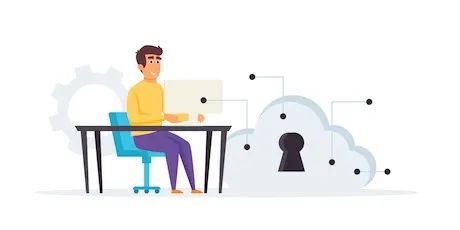A recent Gartner study shows that by 2025, 85% of enterprises will adopt a cloud strategy. Although this figure is for the world, it can be seen that in the Chinese environment, the advantages brought by cloud-based are becoming more and more More and more enterprises are also beginning to actively transform to the cloud.
But at the same time, a report pointed out that 80% of enterprises encountered cloud-related security incidents in the past year.
The cloud brings benefits
The benefit of enterprises adopting cloud is a cliché, so I won’t go into details here, but simply say a few points:
- Cost reduction and efficiency increase: Cloud computing provides flexibility and scalability, helping enterprises to quickly expand or reduce their size as needed, improve efficiency and reduce costs.
- Optimized management: With the cloud-based model, enterprises can break many traditional management shackles and build a new management model.
- Reduce the workload of compliance: In the traditional data center, the entire compliance needs to be solved by the enterprise itself, but in the cloud environment, the underlying part of this work is all transferred to the cloud provider.
The cloud also brings risks

As enterprises rapidly migrate critical infrastructure and data to the cloud, they also face new security issues in the new environment. A recent report revealed that 80% of organizations experienced a security incident related to their cloud infrastructure in the past year.
Technical blind spots that may be faced in the process of migrating to the cloud:
- Ignore bugs and security holes.
- Improper configuration can expose sensitive data and applications to cyber attacks.
- The increased risk of unauthorized access and data breaches is an issue when multiple users access the same cloud services and data.
Additionally, the dynamic nature of cloud environments presents the risk of constant change. With cloud services and technologies rapidly evolving, organizations must keep up with updates, patches and new security threats. Failure to do so can render security measures obsolete, leaving the organization vulnerable.
Cloud security is different from traditional security
Cloud security differs from traditional solutions in that security responsibilities are shared between the organization and the cloud provider. In traditional solutions, organizations are only responsible for security, and cloud providers are only responsible for the underlying infrastructure.
In the cloud security model, organizations are responsible for securing their applications, data, and user access, while cloud providers are responsible for securing the underlying infrastructure, such as servers, networks, and physical data centers. This shift is important because it relieves organizations of the burden of managing and maintaining security infrastructure, allowing them to focus on core business processes. It also means that cloud providers must have strong security measures in place to protect their infrastructure and prevent unauthorized access or data leakage.
The cloud's shared responsibility model requires organizations to take appropriate steps to protect their environments, applications, and data. Failure to do so could result in a non-compliance that could seriously impact the business. A proactive approach to identifying and mitigating cloud security risks remains critical.

Think Security for the Cloud
Focus on risk exposure
Risk exposure in cloud environments is critical for organizations to ensure the security of their data and infrastructure. Organizations need to consider several factors to gain insight into their level of risk and take appropriate steps to mitigate it. This includes:
- Number of users accessing cloud infrastructure: The higher the number of users, the greater the potential for a security breach. Organizations should closely monitor user access and implement strong authentication mechanisms.
- Securely configure cloud infrastructure: Organizations should ensure that all security controls are properly implemented and maintained. This includes regularly updating and patching systems, securely storing and managing encryption keys, and monitoring for misconfigurations.
- Security team familiarity and training in handling cloud incidents: Organizations should have a well-trained and proactive incident response team to detect and respond to security incidents in a timely manner.
- Regular testing and rehearsal process: Organizations can proactively identify and address potential weaknesses before they can be exploited by conducting regular penetration testing and vulnerability assessments.
Cognitive blind spots
Cloud security blind spots are caused by the unique characteristics of cloud environments, which differ from legacy data centers for which security tools were originally designed. Public cloud platforms have ephemeral infrastructure, geographic distribution, and shared responsibility models that undermine traditional security approaches.
Visibility is limited . Cloud providers are responsible for securing the underlying infrastructure, while customers are responsible for securing their applications, data, and user access. This segregation of duties can lead to gaps in security monitoring and incident detection, as customers may need full visibility into the cloud provider's security measures and logs.
Configuration and operation errors . According to Gartner, most cloud security problems are due to customer configuration or operational errors. This highlights the challenges and responsibilities businesses face in ensuring a secure cloud environment. Misconfigurations such as weak access controls, poor encryption, or insufficient monitoring can become exploitable vulnerabilities.
A holistic approach is needed to eliminate cloud security blind spots. This includes continuous inventory of all assets, applying policies and controls at scale, integrating with cloud capabilities, and focusing on workloads and data flows rather than just infrastructure. Leveraging cloud-native capabilities for security is also key, rather than using inadequate legacy toolsets.
Security Challenges in Cloud Environments
Cloud environments are complex and dynamic, which makes them difficult to secure. Here are some challenges:
- Scale and complexity: Cloud environments can have hundreds of thousands of assets, making tracking and securing them both problematic.
- Shared Responsibility Model: Cloud providers and customers share security responsibilities, which can lead to confusion and gaps in coverage.
- Adoption of cloud-native technologies: Cloud-native technologies represented by containers and K8s have risen rapidly in recent years. Many enterprises directly adopt containers when going to the cloud, but their security management capabilities and methods are still lacking.
- Dynamic, borderless, and unstructured environments: Cloud environments are constantly changing, making it difficult to maintain security controls.

meet the challenge
To address these challenges, organizations need to build reasonable comprehensive security capabilities. This includes:
- Tools: To use cloud-native security tools, you must first sharpen your tools if you want to do a good job. Before starting to solve problems, choosing the right tools and solutions can make cloud security construction less detours. By building an automatic capability chain with professional tools, the period from problem discovery to solution can be greatly shortened.
- Personnel: Solving problems must be inseparable from people. Therefore, it is necessary to reserve specialized personnel for cloud security. Cloud security talents with both security and cloud computing knowledge are an indispensable part of enterprises to ensure cloud security.
- Culture: At a deep level, enterprises need to form a culture for the cloud and cloud security. If the culture, process, mechanism, and model of the entire enterprise are still very traditional, then there will be many difficulties in the construction of cloud security. .

About HummerRisk
HummerRisk is an open source cloud-native security platform that solves cloud-native security and governance issues in a non-intrusive manner. Core capabilities include hybrid cloud security governance and K8S container cloud security detection.
GitHub address: https://github.com/chaitin/HummerRisk
Gitee Address: https://gitee.com/hummercloud/HummerRisk